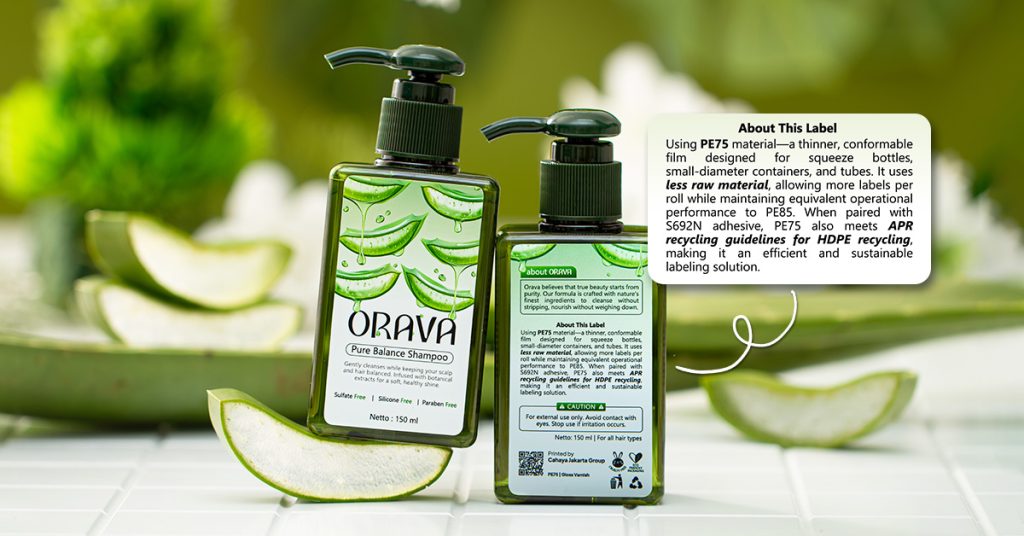
Label stickers are more than just adhesive tags—they are a critical component of product packaging and brand communication. For businesses, especially in the FMCG, cosmetic, or pharmaceutical sectors, well-designed labels help ensure compliance, convey key information, and reflect brand credibility. However, many companies still overlook essential design principles, leading to reduced shelf impact, production inefficiencies, and potential miscommunication with end users.
Below are five common mistakes often found in label sticker design:
Poor Color Selection
Color is one of the most impactful visual elements in label design, serving not only as an aesthetic choice but also as a key driver of brand perception and legibility. Yet, many businesses select colors based on personal taste or fleeting design trends—without considering contrast, material compatibility, or print accuracy.
Low contrast between background and text can severely hinder readability, especially in smaller label formats. Furthermore, color appearance may shift significantly depending on the label material used, such as glossy, matte, metallic, or transparent substrates. Without pre-testing or proper color profiling, these mismatches can result in labels that appear inconsistent or unprofessional—ultimately diminishing consumer trust and brand value.
Text Too Small or Information Overcrowded
Cluttered layouts and overly small text are frequent issues in label design—especially when trying to fit extensive information such as ingredients, usage instructions, production and expiry dates, legal disclaimers, and certifications within a limited print area. While this data may be mandatory for compliance, poor organization often sacrifices clarity and user readability.
Inadequate font sizing and tight spacing reduce legibility, particularly on small-format labels or curved surfaces like bottles and tubes. This not only disrupts the customer’s reading experience but also reflects poorly on the brand’s attention to detail and user-centric design. In regulated industries, this can even lead to non-compliance if critical information is missed or misinterpreted.
Skipping Print Tests on Actual Packaging
Relying solely on on-screen visuals or digital mock-ups without conducting physical print tests is a costly mistake in label production. On-screen designs often fail to account for how labels will behave when applied to real packaging materials—particularly those with curves, textures, or reflective surfaces such as glass, metal, or plastic.
Without physical testing, issues such as color shifts, misaligned text, or key elements being folded over edges can easily go unnoticed. These oversights not only compromise visual impact but can also lead to miscommunication of important product details. For businesses, this translates to increased reprint costs, production delays, and even potential compliance issues.
Ignoring Safe Zones and Bleed Areas
Label production requires a careful balance of visual and technical elements. A frequent mistake is placing important elements—like text, logos, or critical information—too close to the edge of the design. This increases the risk of content being trimmed off during mass production. Neglecting to include a bleed area—a margin beyond the design boundary to accommodate cutting tolerances—can also lead to white edges around the label, detracting from the product’s professional look. Attention to these technical details ensures labels are not only visually appealing but also precise and production-ready.
Overlooking Material and Finishing Choices
Even the most appealing design won’t shine without the right material and finishing. Using generic materials—for instance, standard labels for frozen products—can result in smudging, peeling, or ink running. Likewise, finishing options like matte or glossy should align with the design intent. While matte finishes may appear elegant, they can dull visual highlights if mismatched. Incompatibilities between material and ink can produce blurry results, diminishing the brand’s credibility. A thoughtful combination of materials and finishing is crucial to uphold the label’s quality and overall brand perception.
Designing effective label stickers requires more than just visual appeal—it demands a strategic balance of aesthetics, technical accuracy, and real-world application. The five mistakes outlined above may seem minor, but they often result in reduced packaging performance, higher production costs, and diminished brand perception in the eyes of both consumers and retailers.
For brand owners, creative teams, and production managers, it’s crucial to recognize that labels are not simply decorative elements—they are critical brand assets and communication tools. When executed correctly, label designs can significantly enhance product visibility, strengthen customer trust, and elevate brand positioning in a competitive marketplace.
Need Expert Support on Label Design and Production?
At Cahaya Jakarta, our label specialists work closely with businesses to deliver printing solutions tailored to each product’s packaging, industry standards, and branding goals. Whether you’re launching a new SKU or revamping existing packaging, we’re here to help you optimize every detail—seamlessly and professionally.
Get in touch today to schedule for free consultation or request sample label kits customized for your industry!



